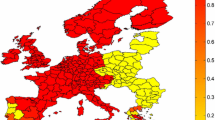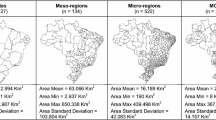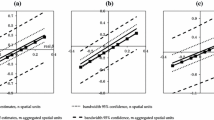Abstract
This paper proposes a new technique based on an iterated spatially weighted regression procedure to verify the presence of economic growth heterogeneities in EU regions in the period 1981–2009. The approach extends a procedure originally proposed in the field of image analysis based on the assumption of local homogeneity of the signal. The presence of the heterogeneity is a criterion to divide the sample of observations (i.e. regions) into smaller homogeneous groups. Our results highlight the presence in the EU regions of five different clubs with different growth paths within each subgroup. Spatial dependence is also considered in the definition of the economic convergence model.


Similar content being viewed by others
Notes
Euclidean and contiguity distance matrices were also considered, but methodological considerations and empirical results suggest to choose the normalized distance from the five nearest neighbor’s regions.
We are aware that the interpretation of parameters estimates in a spatially lagged model, as SDM, should be performed using impact measures as highlighted by LeSage and Pace (2009). However, for the sake of simplicity, we report the impact measures only for the local models (i.e., convergence clubs) identified through the ISWR.
The procedure was tested with different settings of η in the interval [0;1], with not significant differences in the final identification of the homogeneous groups.
Polzehl and Spokoiny (2000) use a scale parameter equivalent to our 1/τ.
References
Anselin, L.: Spatial econometrics: Methods and models. Kluwer Academic Publishers, Dordrecht (1988)
Azariadis, C., Drazen, A.: Threshold externalities in economic development. Q. J. Econ. 105, 501–526 (1990)
Barro, R.J.: Economic growth in a cross section of countries. Q. J. Econ. 106, 407–443 (1991)
Barro, R.J., Sala-i-Martin, X.: Convergence across states and regions. Brook. Pap. Econ. Act. 22, 107–182 (1991)
Barro, R.J., Sala-i-Martin, X.: Economic Growth Theory. Mc Graw-Hill, Boston (1995)
Bartkowska, M., Riedl, A.: Regional convergence clubs in Europe: identification and conditioning factors. Econ. Model. 29, 22–31 (2012)
Battisti, M., Di Vaio, G.: A spatially filtered mixture of convergence regression or EU regions, 1980–2002. Empir. Econ. 34, 105–121 (2008)
Baumol, W.: Productivity growth, convergence and welfare: what the long-run data show. Am. Econ. Rev. 76, 1072–1085 (1986)
Bernardini Papalia, R., Bertarelli, S.: Identification and estimation of club convergence models with spatial dependence. Int. J. Urban Reg. Res. 37, 2094–2115 (2013)
Boldrin, M., Canova, F.: Inequality and convergence in Europe’s regions: reconsidering European regional policies. Econ. Policy 32, 205–245 (2001)
Brunsdon, C., Fotheringham, A.S., Charlton, M.E.: Geographically weighted regression: a method for exploring spatial non-stationarity. Geogr. Anal. 28, 281–298 (1996)
Canova, F.: Testing for convergence clubs in income per capita: a predictive density approach. Int. Econ. Rev. 45, 49–77 (2004)
Corrado, L., Martin, R., Weeks, M.: Identifying and interpreting regional convergence clusters across Europe. Econ. J. 115, 133–160 (2005)
Cuadrado, J.R.: Regional convergence in the European Union: from hypothesis to the actual trends. Ann. Reg. Sci. 35, 333–356 (2001)
Cuadrado-Roura, J.R., Mancha-Navarro, T., Garrido-Yserte, R.: Regional dynamics in the European Union: winners and losers. In: Cuadrado-Roura, J.R., Parellada, M. (eds.) Regional Convergence in the European Union. Springer, Berlin (2002)
Dall’Erba, S., Le Gallo, J.: Regional convergence and the impact of European Structural Funds over 1989–1999: a spatial econometric analysis. Pap. Reg. Sci. 87, 219–244 (2008)
Díaz, A., Fernández, E., Rubiera, F.: The role of spatial scale in regional convergence: the effect MAUP in the estimation of β-convergence equations. Ann. Reg. Sci. 56, 473–489 (2016)
Durlauf, S., Johnson, P.A.: Multiple regimes and cross-country behaviour. J. Appl. Econom. 10, 365–384 (1995)
Elhorst, J.P.: Applied spatial econometrics: raising the bar. Spat. Econ. Anal. 5, 9–28 (2010)
Elhorst, J.P.: Spatial Econometrics. From Cross-Sectional Data to Spatial Panels. Springer, Berlin (2014)
Elhorst, P., Piras, G., Arbia, G.: Growth and convergence in a multi-regional model with space–time dynamics. Geogr. Anal. 42, 338–355 (2010)
Ertur, C., Koch, W.: Growth, technological interdependence and spatial externalities: theory and evidence. J. Appl. Econom. 22, 1033–1062 (2007)
Escribá, J., Murgui, J.M.: La base de datos BD.EURS (NACE Rev. 1). Investig. Reg. 28, 173–194 (2014)
Feve, P., LePen, Y.: On modeling convergence clubs. Appl. Econ. Lett. 7, 311–314 (2000)
Fischer, M.M.: A spatial Mankiw–Romer–Weil model: theory and evidence. Ann. Reg. Sci. 47, 419–436 (2011)
Fischer, M.M., Stirböck, C.: Pan-European regional income growth and club-convergence—insights from a spatial econometric perspective. Ann. Reg. Sci. 40, 693–721 (2006)
Fotheringham, A.S., Brunsdon, C., Charlton, M.: Geographically Weighted Regression: The Analysis of Spatially Varying Relationships. Wiley, Chichester (2002)
Galor, O.: Convergence? Inference from theoretical models. Econ. J. 106, 1056–1069 (1996)
Islam, N.: Growth empirics: a panel data approach. Q. J. Econ. 110, 1127–1170 (1995)
Islam, N.: What have we learnt from the convergence debate? J. Econ. Surv. 17, 309–362 (2003)
Jones, C.I.: Sources of U.S. economic growth in a world of ideas. Am. Econ. Rev. 92, 220–239 (2002)
Le Gallo, J., Dall’erba, S.: Evaluating the temporal and spatial heterogeneity of the European convergence process, 1988–1999. J. Reg. Sci. 46, 269–288 (2006)
Le Gallo, J., Dall’erba, S., Guillan, R.: The local versus global dilemma of the effects of structural funds. Growth Change 42, 466–490 (2011)
LeSage, J., Pace, K.: Introduction to Spatial Econometrics. CRC Press, Boca Raton (2009)
Lòpez-Bazo, E., Vayà, E., Mora, A.J., Surinach, J.: Regional economic dynamics and convergence in the European Union. Ann. Reg. Sci. 33, 343–370 (1999)
Mankiw, N.G., Romer, D., Weil, D.N.: A contribution to the empirics of economic growth. Q. J. Econ. 7, 407–437 (1992)
Martin, P., Ottaviano, P.: Growth and agglomeration. Int. Econ. Rev. 42, 947–968 (2001)
Metropolis, N., Rosenbluth, A.W., Rosenbluth, M.N., Teller, A.H., Teller, E.: Equations of state calculations by fast computing machines. J. Chem. Phys. 21, 1087–1092 (1953)
Perugini, C., Martino, G.: Income inequality within European regions: determinants and effects on growth. Rev. Income Wealth 54, 373–406 (2008)
Polzehl, J., Spokoiny, V.: Adaptive weights smoothing with applications to image segmentation. J. R. Stat. Soc. B 62, 335–354 (2000)
Polzehl, J., Spokoiny, V.: Image denoising: pointwise adaptive approach. Ann. Stat. 31, 30–57 (2003a)
Polzehl, J., Spokoiny, V.: Varying coefficient regression modeling. WIAS, Berlin (2003b). (Preprint 818)
Polzehl, J., Spokoiny, V.: Propagation-separation approach for local likelihood estimation. Probab. Theory Relat. Fields 135, 335–362 (2006)
Postiglione, P., Benedetti, R., Lafratta, G.: A regression tree algorithm for the identification of convergence clubs. Comput. Stat. Data Anal. 54, 2776–2785 (2010)
Postiglione, P., Andreano, M.S., Benedetti, R.: Using constrained optimization for the identification of convergence clubs. Comput. Econ. 42, 151–174 (2013)
Ramajo, J., Màrquez, M.A., Hewings, G.J.D., Salinas, M.M.: Spatial heterogeneity and interregional spillovers in the European Union: do cohesion policies encourage convergence across regions? Eur. Econ. Rev. 52, 551–567 (2008)
Rey, S.J., Montouri, B.D.: US regional income convergence: a spatial econometric perspective. Reg. Stud. 33, 143–156 (1999)
Sala-i-Martin, X.: Regional cohesion: evidence and theories of regional growth and convergence. Eur. Econ. Rev. 40, 1325–1352 (1996)
Temple, J.: The new growth evidence. J. Econ. Lit. 37, 112–156 (1999)
Author information
Authors and Affiliations
Corresponding author
Appendix
Appendix
1.1 Main steps
-
1.
Initialization for each region i calculate initial estimates \({\hat{\mathbf{b}}}^{0} (i)\) with standard GWR, where \(g_{ij}^{0} = K_{d} (d_{ij} ) = e^{{ - \gamma d_{ij} }}\) and compute \({\mathbf{\hat{\sigma }}}_{\varepsilon }^{2}\);
-
2.
Main step: computation of the weights \(\dot{g}_{ij}^{l}\) at each iteration l compute the statistics \(T_{ij}^{l} = \left( {{\hat{\mathbf{b}}}^{l - 1} (i) - {\hat{\mathbf{b}}}^{l - 1} (j)} \right)\hat{\Sigma }^{ - 1} \left( {{\hat{\mathbf{b}}}^{l - 1} (i) - {\hat{\mathbf{b}}}^{l - 1} (j)} \right)^{t}\), \(K_{d} (d_{ij}^{l} )\), \(K_{T} (T_{ij}^{l} )\) and determine \(g_{ij}^{l} = K_{d} (d_{ij}^{l} ) \cdot K_{T} (T_{ij}^{l} ) = \left( {e^{{ - \gamma d_{ij} /l}} } \right) \cdot \left( {e^{{ - \tau T_{ij}^{l} }} } \right)\). Apply the convex combination \(\dot{g}_{ij}^{l} = (1 - \eta )g_{ij}^{l} + \eta \dot{g}_{ij}^{l - 1}\) to determine the new weights that represent the elements of G l;
-
3.
Stopping if \(\hbox{max} \left| {\dot{g}_{ij}^{l - 1} - \dot{g}_{ij}^{l} } \right| < \omega ,\quad \forall i,j\) with ω a fixed small value, the procedure is stopped. The final weight matrix is G* with generic element given by \(g_{ij}^{*}\). Otherwise continue;
-
4.
Estimation of the new model use \(\bf {\text{G}}^{ * } (i)\), diagonal matrix with the elements of main diagonal constituted by the i-th row of G*, to estimate the parameters of the model.
Rights and permissions
About this article
Cite this article
Andreano, M.S., Benedetti, R. & Postiglione, P. Spatial regimes in regional European growth: an iterated spatially weighted regression approach. Qual Quant 51, 2665–2684 (2017). https://doi.org/10.1007/s11135-016-0415-1
Published:
Issue Date:
DOI: https://doi.org/10.1007/s11135-016-0415-1




